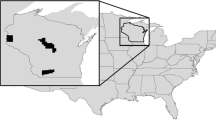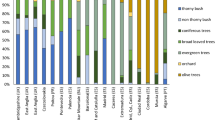Abstract
Investigations using available data sought to guide short-term management decisions regarding the needs of northern spotted owl in the high Cascade Mountains of Oregon. Landscape attributes and pattern indices were measured and tested for identification of areas likely to contain northern spotted owl nests. Predictive models indicating planning standards were developed. Most landscape ecological indices were not useful. Results indicate the owl favors landscapes dominated by patches that meet definitions of late seral forest nesting habitat. The owl optimally nests in such patches at least 570 hectares in size. Landscapes with some edges, particularly around nesting habitat patches evidently do not adversely affect the owl, perhaps because they provide prey. Landscapes with extensive edges, particularly between openings and forests not suitable for nesting, are not as likely to be selected. The results are largely consistent with the owl's recovery plans, provide guidance for management, and require refinement through additional research, particularly to better determine home range sizes.
Similar content being viewed by others
References
Carey, A.B., J.A. Reid and S.P. Horton, 1990. Spotted owl home range and habitat use in Southern Oregon Coast Ranges. J.Wildl. Manage. 54(1): 11–17.
Coonce, L.F, 1990. Winema National Forest Land and Resource Management Plan. USDA Forest Service, Pacific Northwest Region, Winema National Forest, Klamath Falls, Oregon.
Cutler, T.L. and D.W. Hays, 1991, Food habits of northern spotted owls in high elevation forests of Pelican Butte, Southwestern Oregon. Northwestern Naturalist 72: 66–69.
Diaz, N. and D. Apostal, 1992. Forest landscape analysis and design: a process for developing and implementing land management objectives for landscape patterns. USDA Forest Service, Region 6, Publication ECO-TP–043–92.
Forman, R.T.T. and M. Godron, 1986. Landscape Ecology. John Wiley and Sons, New York.
Forsman, E.D, 1980. Habitat utilization by spotted owls in the westcentral Cascades of Oregon. Dissertation, Oregon State University, Corvallis, Oregon.
Forsman, E.D. and E.C. Meslow, 1984. Distribution and biology of the spotted owl in Oregon. Wildl. Monogr. 87: 1–64.
Franklin, J.F. and C.T. Dyrness, 1973. Natural vegetation of Oregon and Washington. Oregon State University Press, Corvallis, Oregon.
Franklin, J.F. and R.T.T. Forman, 1987. Creating landscape patterns by forest cutting: ecological consequences and principles. Landsc. Ecol. 1(1): 5–18.
Hansen, A.J., T.A. Spies, F.J. Swanson and J.L. Ohmann, 1991. Conserving biodiversity in managed forests: lessons from natural forests. Biosci. 41(6): 382–392.
Hansen, J. and D. Urban, 1992. Avian response to landscape pattern: the role of species' life histories. Landsc. Ecol. 7(3): 163–180.
Hardy, R. 1992. (pers. comm.). USDA Forest Service, Winema National Forest, Klamath Ranger District, Wildlife Biology Office.
Harris, L.D. 1984. The fragmented forest: island biogeography theory and the preservation of biotic diversity. University of Chicago Press, Chicago, Illinois.
Harris, L.D. 1988. Edge effects and the conservation of biotic diversity. Conserv. Biol. 2: 330–332.
Haugen, J. 1993. Fourteen potential indicators of northern spotted owl habitat, statistical analysis: report to the Klamath District ranger on Klamath District ecosystem analysis. Winema National Forest, Klamath Falls, Oregon.
Hopkins, W.E. 1979. Plant associations of south Chiloquin and Klamath Ranger Districts, Winema National Forest. USDA Forest Service, Pacific Northwest Region, Report R6-Ecol–70–005, Portland, Oregon.
Hulse, D.W. and R.Z. Melnick, 1990. GIS as an aid to rural landscape protection. In: Proceedings: Resource Technology '90, Second International Symposium on Advanced Technology in Natural Resource Management. American Society for Photgrammetry and Remote Sensing, Bethesda, Maryland.
Jahns, P. 1992. Owl habitat parameters: report to the Klamath District ranger on site specific spotted owl habitat. Winema National Forest, Klamath Falls, Oregon.
Krummel, J.R., R.H. Gardner, G. Sugihara, R.V. O'Neill and P.R. Coleman. 1987. Landscape patterns in a disturbed environment. Oikos 48: 321–324.
Li, H. 1989. Spatial-temporal pattern analysis of managed forest landscapes: a simulation approach. Dissertation, Oregon State University, Corvallis, Oregon.
Li, H. and J. Franklin, 1988. Landscape ecology: a new conceptual framework in ecology. Advance in Ecology (China) 5(1): 23–33.
Loehle, C. 1990. Home range: a fractal approach. Landsc. Ecol. 5: 39–52.
Lujan, M. Jr., D.R. Knowles, J. Turner, M. Plenert, J. Bart, R.G. Anthony, M. Berg, J.H. Beuter, W. Elmore, J. Fay, R.J. Gutierrez, H.T. Heintz, Jr., R.S. Holthausen, K. Lathrop, K. Mays, R.H. Nafziger, M. Pagel, C. Sproul, E.E. Starkey and J.C. Tappenier, 1992. Draft recovery plan for the northern spotted owl. USDI Fish and Wildlife Service, Washington, DC.
Mandelbrot, B.B. 1977. Fractals; form, chance and dimension. Freeman, San Francisco.
Maser, C., B.R. Mate, J.F. Franklin and C.T. Dyrness, 1981. Natural history of Oregon coast mammals. USDA Forest Service General Technical Report PNW-133. Portland, Oregon. 496 pp.
McGarigal, K. and B. Marks, 1993. FRAGSTATS: spatial pattern analysis program for quantifying landscape structure. Forest Science Department, Oregon State University, Corvallis, Oregon.
McLellan, C.H., A.P. Dobson, D.S. Wilcove and J.F. Lynch, 1986. Effects of forest fragmentation on new-and old-world bird communities: empirical observations and theoretical implications. In: Wildlife 2000: Modeling Habitat Relationships of Terrestrial Vertebrates. pp. 305–313. Edited by J. Verner, M.L. Morrsion and C.J. Ralph. University of Wisconsin Press, Madison, Wisconsin.
Morganti, R. in press. Landscape patterns in wildlife habitat: the landscape ecology of the northern spotted owl in the eastern high Cascades of southern Oregon: a preliminary test of pattern indices. J. Remote Sens.
Ollieu, M. 1992. Report from the regional director of forest pest managment, functional assistance trip to the Winema National Forest. USDA Forest Service, Pacific Northwest Region, Portland, Oregon.
O'Neill, R.V., J.R. Krummel, R.H. Gardner, G. Sugihara, B. Jackson, D.L. DeAngelis, B.T. Milne, M.G. Turner, B. Zygmunt, S.W. Christensen, V.H. Dale and R.L. Graham, 1988. Indices of landcape pattern. Landsc. Ecol. 1(3): 153–162.
Patton, D.R. 1992 Wildlife habitat relationships in forested ecosystems. Timber Press, Portland, Oregon.
Perry, D.A. 1988. An overview of sustainable forestry. J. Pest. Ref. 8: 8–12.
Perry, D.A. and M.P. Amaranthus, 1997. Disturbance, recovery, and stability. In: Creating a forestry for the 21st century. pp. 31–56. Edited by K.A. Kohm and J.F. Franklin. Island Press, Washington, DC.
Perry, D.A. and J. Maghembe, 1989. Ecosystem concepts and current trends in forest management: time for reappraisal. For. Ecol. and Manage. 26: 123–140.
Ripple, W.J., G.A. Bradshaw and T.A. Spies, 1991. Measuring forest landscape patterns in the Cascade Range of Oregon, USA. Conserv. Biol. 57: 73–88.
Rosenberg, K.V. and M.G. Raphael, 1986. Effects of forest fragmentation on vertebrates in Douglas-fir forests. In: Wildlife 2000: modeling habitat relationships of terrestrial vertebrates. pp. 263–272. Edited by J. Verner, M.L. Morrison and C.J. Ralph. University of Wisconsin Press, Madison, Wisconsin.
Thomas, J.W. (Technical Editor), 1979. Wildlife habitats in managed forests: the Blue Mountains of Oregon and Washington. USDA Forest Service, Agricultural Handbook No. 553, Washington, DC.
Thomas, J.W., E.D. Forsman, J.B. Lint, E.C. Meslow, B.R. Noon and J. Verner. 1990. A conservation strategy for the northern spotted owl: report of the interagency scientific committee to address the conservation of the northern spotted owl. USDA Forest Service, USDI Bureau of Land Management, USDI Fish and Wildlife Service, USDI National Park Service, Washington, DC.
Thomas, J.W., M.G. Raphael, R.G. Anthony, E.D. Forsman, A.G. Gunderson, R.S. Holthausen, B.G. Marcot, G.H. Reeves, J.R. Sedell and D.M. Solis, 1993. Viability assessments and management considerations for species associated with late-successional and old-growth forests of the pacific northwest: the report of the scientific analysis team (SAT). USDA Forest Service, National Research Office, Washington, DC.
Turner, M.R. 1990. Spatial and temporal analysis of landscape patterns. Landsc. Ecol. 4(1): 21–30.
Turner, M.R., R. Constanza and F.H. Sklar, 1989. Methods to evaluate the performance of spatial simulation models. Ecol. Model. 48: 1–18.
U.S. Department of Agriculture and U.S. Department of Interior, 1994. Record of decision: for amendments to forest service and bureau of land management planning documents within the range of the northern spotted owl; and standards and guidelines: for management of habitat for late-successional and oldgrowth forest related species within the range of the northern spotted owl. U.S. Government Printing Office, Document 1994–589–111/00001 Region no. 10.
U.S. Fish and Wildlife Service, 1990. 1990 status review: northern spotted owl; Strix occidentalis caurina. Report to the Fish and Wildlife Service. Portland, Oregon. U.S. Department of the Interior.
U.S. Fish and Wildlife Service, U.S. Bureau of Land Management and U.S. Department of Agriculture Forest Service. 1994. Section 7 consultation guidance for the forest ecosystem plan: fiscal year 1994 and 1995 projects. Memorandum of understanding dated December 22, 1994.
Wallin, D.O., F.J. Swanson and B. Marks, 1994. Landscape pattern response to changes in the pattern-generation rules: land-use legacies in forestry. Ecol. Applic. 4(3): 569–580.
Author information
Authors and Affiliations
Rights and permissions
About this article
Cite this article
Ribe, R., Morganti, R., Hulse, D. et al. A management driven investigation of landscape patterns of northern spotted owl nesting territories in the high Cascades of Oregon. Landscape Ecology 13, 1–13 (1998). https://doi.org/10.1023/A:1007976931500
Issue Date:
DOI: https://doi.org/10.1023/A:1007976931500




